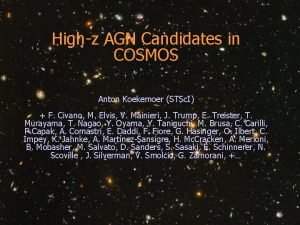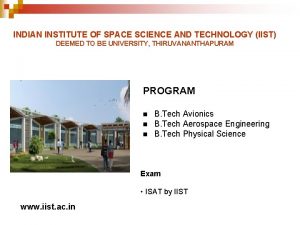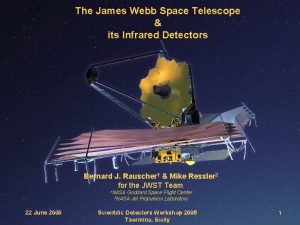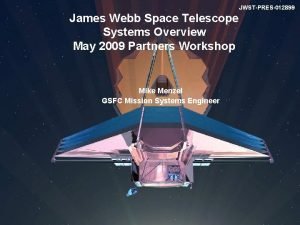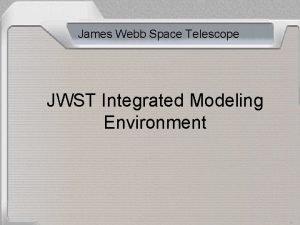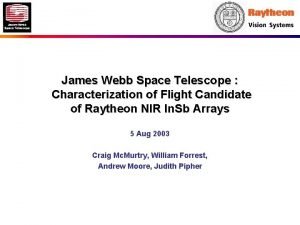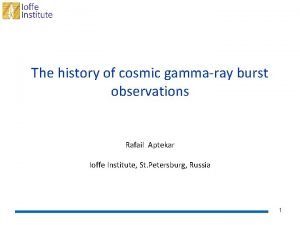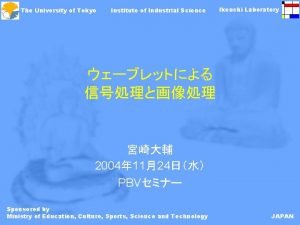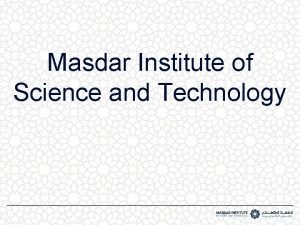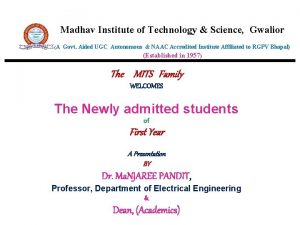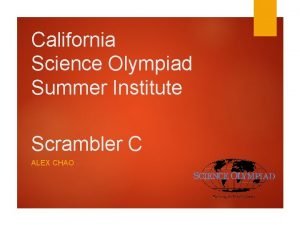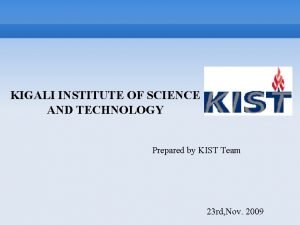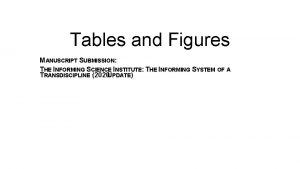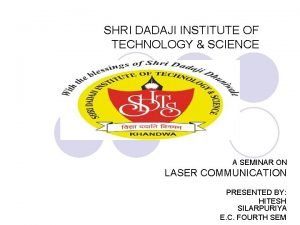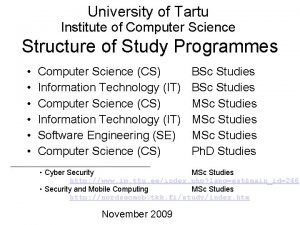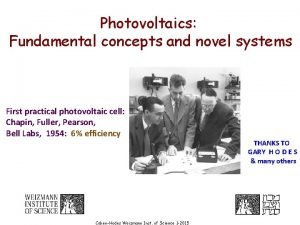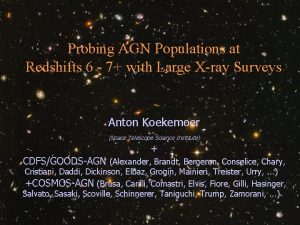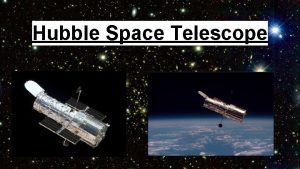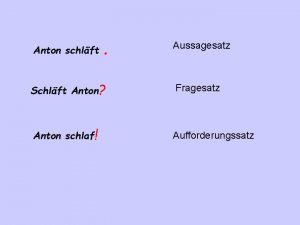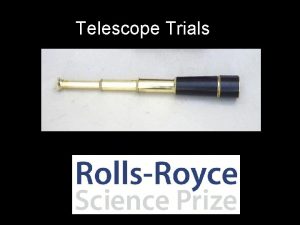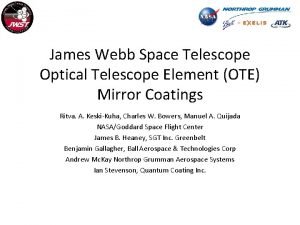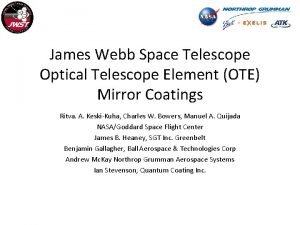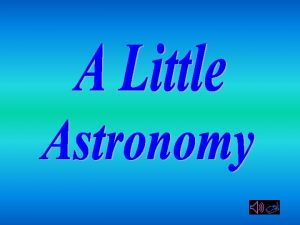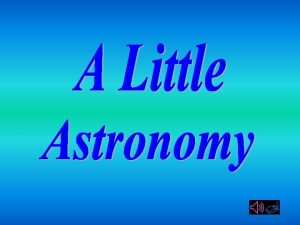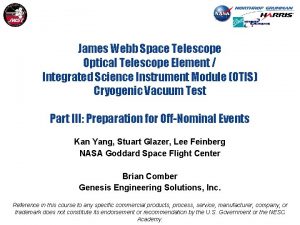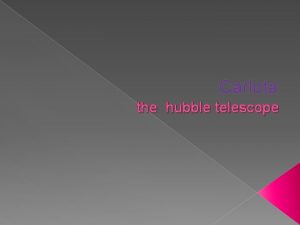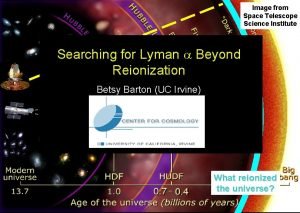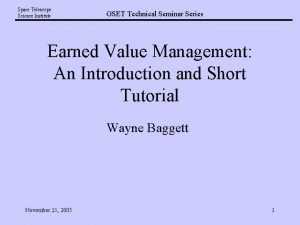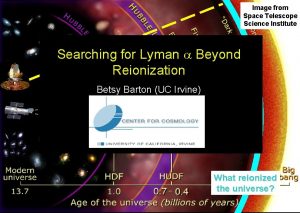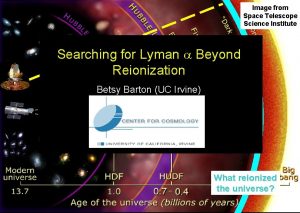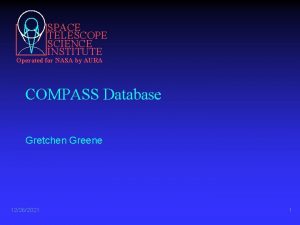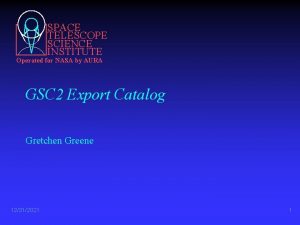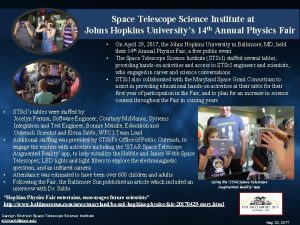Anton Koekemoer Space Telescope Science Institute Anton Koekemoer























- Slides: 23

Anton Koekemoer (Space Telescope Science Institute) Anton Koekemoer (STSc. I) Extragalactic X-Ray Surveys - Cambridge, MA, 6 Nov 2006 Probing AGN Populations at Redshifts 6 - 7+ with Large X-ray Surveys 1 + CDFS/GOODS-AGN (Alexander, Brandt, Bergeron, Conselice, Chary, Cristiani, Daddi, Dickinson, Elbaz, Grogin, Mainieri, Treister, Urry, . . . ) +COSMOS-AGN (Brusa, Carilli, Comastri, Elvis, Fiore, Gilli, Hasinger, Salvato, Sasaki, Scoville, Schinnerer, Taniguchi, Trump, Zamorani, . . . )

Black holes in the context of reionization: May trace hierarchical dark matter halos l Provide harder ionizing continuum than stars l May regulate galaxy growth / SFR via feedback l M-s relation suggests intimate connection between BH/galaxy formation and growth Current knowledge: At z ~ 6 - 6. 5, already have supermassive BHs up to M ~ 3 x 109 Mo (Fan et al 2001+; Willott et al. 2003) l High-luminosity end of AGN LF evolves strongly from z~6 to z~2; PLE is ruled out (Fan et al. 2001+; Richards et al. 2006) l Anton Koekemoer (STSc. I) Extragalactic X-Ray Surveys - Cambridge, MA, 6 Nov 2006 l 2

Instead of PLE, AGN appear to follow “downsizing” -luminosity-dependent density evolution “LDDE” -- for X -ray LF (Ueda et al. 2003, Hasinger et al. 2005) and also for QSO LF (Richards et al. 2006): – luminous AGN peak earlier (z~2 -3) – fainter AGN peak more recently (z~1) (XLF; Hasinger et al. 2005) Anton Koekemoer (STSc. I) Extragalactic X-Ray Surveys - Cambridge, MA, 6 Nov 2006 l 3 (QSO LF, Richards et al. 2006)

Questions: How do the most massive BHs form within < 1 Gyr? l How does BH growth influence the M-s relation? l What is the ionizing budget of AGN integrated over the LF beyond z ~ 6, and its contribution to reionization? l (How) does obscured/unobsc. AGN ratio evolve at z > 6? Our knowledge has been limited by the following: only the top of the AGN LF has been studied at z ~ 6 l no AGN currently confirmed at z > 7 l Anton Koekemoer (STSc. I) Extragalactic X-Ray Surveys - Cambridge, MA, 6 Nov 2006 l 4 Approach: Set out to quantify the faint end of AGN LF at z ~ 6 l Search for more luminous AGN at z > 6 - 7 l

Require Wide+Deep X-ray / Optical / IR Surveys: Depth probes faint/moderate-lum AGN to high z l Area probes high-lum AGN at high z l (Hard) X-rays penetrate obscuring torus, IR probes restframe optical emission from AGN + host galaxy New part of parameter space: 5 Combined optical + X-ray depth allows wider exploration of FX/FOpt: log FX (erg s-1 cm-2) Anton Koekemoer (STSc. I) l N AG Extragalactic X-Ray Surveys - Cambridge, MA, 6 Nov 2006 l FOpt (mag)

CDFS/GOODS-S+N survey: powerful combination of wide area and depth, opt/Xray: CDFS + CDFN have 1 & 2 Msec Chandra depth respectively l X-ray depth sufficient for AGN LF faint end (L X~1043 -44 erg s 1) up to z ≥ 6 - 7 l area sufficient (0. 1 sq deg) to provide number statistics on AGN LF at these redshifts l More than 800 AGN from Chandra in GOODS-N & S (> 600 covered by HST/ACS and Spitzer) l Extensive optical spectroscopic coverage l deep multi-band optical/NIR coverage Anton Koekemoer (STSc. I) Extragalactic X-Ray Surveys - Cambridge, MA, 6 Nov 2006 l l Spitzer/IRAC 3. 6 – 8 mm observations trace host stellar mass for z > 1 -2 Spitzer/MIPS 24 mm data helps constrain thermal dust emission

X-ray data: l CDFS (Giacconi, Hasinger et al. 2001+): – 940 ksec divided over 11 intervals, one orientation CDFN (Brandt et al. 2001+): – 2 Msec, on original Hubble Deep Field (HDFN) CDFS Anton Koekemoer (STSc. I) Extragalactic X-Ray Surveys - Cambridge, MA, 6 Nov 2006 l 7 CDFN

Selection criteria: t= op 1 10 0. Expect mostly obscured sources, but unobscured AGN are not excluded Highest FX/FOpt: 8 u uu uu found in several studies so far (Koekemoer et al 2002; Tozzi et al 2002; Brusa et al. 2004; Koekemoer et al 2004, 2006) l EXO’s - Extreme X-ray / Optical sources l Anton Koekemoer (STSc. I) Extragalactic X-Ray Surveys - Cambridge, MA, 6 Nov 2006 /F FX t= l op – Drop-outs in z 850 lp (>27) – Anomalous Fx/Fopt (>100) – Red z 850 lp - K (>4) /F Based on SED change with z: FX l CDFS (Brandt et al, Koekemoer et al, 2001 - 2005) – – Only revealed by extending optical depth below ~27 Optically faint sources with anomalously high FX/FOpt >100 Typically have extremely red z-K > 4 -6 Appear to have no comparable analogs in the local universe

Candidate high-z AGN: X-ray properties: Well-detected by Chandra (~10 -16 -10 -15 erg s-1 cm-2) l FX/FOpt is a lower limit, and is > ~100 x above the average for AGN l Similar number in CDFN l Generally have soft and hard X-ray emission (excludes z<2 obscured AGN) Anton Koekemoer (STSc. I) Extragalactic X-Ray Surveys - Cambridge, MA, 6 Nov 2006 l 9 Redder z-K colour: most AGN with FX/FOpt ~ 0. 1 - 10 have fairly tight z-K ~1 -2, with some slight scatter: – z-K ~ -1 to 2 for quasars/Seyferts – z-K ~ 2 to 4 for ERO’s l However, the EXO high-z candidates generally have z-K >4 l

Anton Koekemoer (STSc. I) Extragalactic X-Ray Surveys - Cambridge, MA, 6 Nov 2006 EXO high-z candidates from GOODS HST/ACS 10 VLT+NOAO SPITZER/IRAC MIPS

Anton Koekemoer (STSc. I) Extragalactic X-Ray Surveys - Cambridge, MA, 6 Nov 2006 EXO Close-up (contours = Chandra 0. 5 -8 ke. V) 11

SEDs: NIR+Spitzer Colours: Optical-NIR: red l NIR-IRAC: red l within IRAC: – generally red – some flat/blue Anton Koekemoer (STSc. I) Extragalactic X-Ray Surveys - Cambridge, MA, 6 Nov 2006 l 12 HST/ACS BViz limits • 28

High-z Candidate SED Constraints Two fundamental observational constraints: NIR/IRAC colours - generally red for EXO’s: – typically K - IRAC 1 (or IRAC 2) ~ 2 mag(AB) – some of the sources have K - IRAC ~ 3 mag l IRAC colours: – Some have red IRAC 1 -IRAC 3 (or IRAC 2 -IRAC 4) – Others have flat or blue IRAC colours Goal of SED fitting: l Anton Koekemoer (STSc. I) Extragalactic X-Ray Surveys - Cambridge, MA, 6 Nov 2006 l 13 Explore a full grid of parameters to differentiate high-z from lower-z (eg z~2 -3 “red and dead” DRGs, etc): – use Charlot & Bruzual (2003), also Maraston (2005 -2006) – combine SSP + CSP – reddening laws (Calzetti, LMC, SMC, galactic) l Several sources may have 2 redshift peaks (z~2 -3, or a high -z alternative); consider both possibilities in that case

SED Fitting Parameterization: l l l h - stellar mass formed as SSP / CSP t - reddening (Fall & Charlot; Calzetti; SMC; LMC) Fits driven by two observational features: red opt/NIR - IRAC colours l colours within IRAC l Anton Koekemoer (STSc. I) Extragalactic X-Ray Surveys - Cambridge, MA, 6 Nov 2006 l redshift Mass 14 General results: a number of the z 850 lp>27 sources are indeed fit by z~2 -3 old populations with little or no dust l younger models requiring more dust l host galaxies typically underluminous (c. f. AGN locally) l

some examples (from GOODS): some EXOs are fit by z~2 -3 evolved or dusty SEDs l others have higher-z fits l host galaxies typically underluminous (c. f. AGN locally) l Mainieri et al 2005 (JHK), Koekemoer et al 2006 (Spitzer) Anton Koekemoer (STSc. I) Extragalactic X-Ray Surveys - Cambridge, MA, 6 Nov 2006 l 15

Old populations with little/no reddening: l l l Anton Koekemoer (STSc. I) Extragalactic X-Ray Surveys - Cambridge, MA, 6 Nov 2006 l 16 z ~ 2. 5 - 5 t~0 -1 h~0 M ~ 109 - 1010 Mo

Younger populations requiring more reddening: l l l Anton Koekemoer (STSc. I) Extragalactic X-Ray Surveys - Cambridge, MA, 6 Nov 2006 l 17 z~2 -4 t~5 h~0 M ~ 109. 3 - 109. 7 Mo

Anton Koekemoer (STSc. I) Extragalactic X-Ray Surveys - Cambridge, MA, 6 Nov 2006 Candidate z>7 AGN: 18

Constraining high-z AGN LF: Use Ueda / Hasinger / Gilli hard X-ray XLF to estimate expected number of optically unidentified sources as a function of redshift l Most of the optically unidentified AGN are evolved interlopers at intermediate z > 2 l Compare with observed number of undetected sources: – use existing X-ray detection limits – apply optical detection cut-off (z(AB) ~ 27. 5 for ACS) Integrate over X-ray luminosities at each redshift bin l Use the difference to calculate cumulative number N(>6) l Compare with N(>6) from XLF l Anton Koekemoer (STSc. I) Extragalactic X-Ray Surveys - Cambridge, MA, 6 Nov 2006 l 19

Constraints on z~7 AGN LF: at z~7, sensitive to Lx ~ 1044 erg s-1 cm-2 l Expected ~3 sources, found 1 candidate so far l other sources are ruled out as lower-z interlopers l Convert this to a limit on the LDDE XLF: z~7 Anton Koekemoer (STSc. I) Extragalactic X-Ray Surveys - Cambridge, MA, 6 Nov 2006 l 20 Thus, possible slight change in low end of AGN LF at z>7 l Supports continued “downsizing”, ie fewer low-lum AGN, thus fewer minor accretion events compared with major mergers or high-luminosity AGN fuelling l

Next: Expand the EXO sample - COSMOS Anton Koekemoer (STSc. I) Extragalactic X-Ray Surveys - Cambridge, MA, 6 Nov 2006 l 21 600 orbits of HST/ACS, i-band, 27 th mag

COSMOS HST/ACS: 2 million galaxies, ~1300 AGN (XMM: Hasinger et al, Brusa et al 2006) + radio (Schinnerer et al) ~1. 4° Anton Koekemoer (STSc. I) Extragalactic X-Ray Surveys - Cambridge, MA, 6 Nov 2006 l 22

Conclusions: Overall number of AGN found in GOODS agrees with that expected based on LDDE l Intermediate-z interlopers successfully accounted for l Found at least 1 plausible candidate z > 7 AGN in GOODS; compared with 3 expected from extending LDDE to z ~ 7 l Thus LDDE appears to extend up to at least z ~ 7 (although possible additional decr in faint end of AGN LF) l Suggests that AGN growth/accretion mechanisms continue to track galaxy growth into reionization: Anton Koekemoer (STSc. I) Extragalactic X-Ray Surveys - Cambridge, MA, 6 Nov 2006 l 23 – AGN feedback regulating star formation up to early epochs – black holes tracing dark matter halos since at least z ~ 7 l Next steps: – larger/deeper multi-band area coverage is needed to improve the sample statistics – deep red optical + IR spectroscopy is also needed!
 Anton koekemoer
Anton koekemoer Iist pune
Iist pune High definition space telescope
High definition space telescope James webb space telescope nasa
James webb space telescope nasa Ote
Ote James webb space telescope
James webb space telescope Raytheon james webb space telescope
Raytheon james webb space telescope James webb nasa space telescope launch
James webb nasa space telescope launch Venera 14 images
Venera 14 images Why science is my favourite subject
Why science is my favourite subject Ramraj science institute nashik
Ramraj science institute nashik Ulsan national institute of science and technology (unist)
Ulsan national institute of science and technology (unist) Institute of industrial science the university of tokyo
Institute of industrial science the university of tokyo Masdar institute of science and technology
Masdar institute of science and technology Madhav institute of technology and science
Madhav institute of technology and science What is this
What is this Korea institute of sport science
Korea institute of sport science Schorarly
Schorarly Informing science institute
Informing science institute Science olympiad summer institute
Science olympiad summer institute Hong kong institute of technology
Hong kong institute of technology Shri dadaji institute of technology and science
Shri dadaji institute of technology and science University of tartu institute of computer science
University of tartu institute of computer science Weizmann institute of science
Weizmann institute of science
